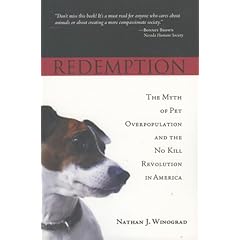
Redemption is a fascinating account of the campaign to end the killing of healthy pets in American animal shelters.
From similar beginnings, animal protection societies evolved very differently in the US and the UK. In this country the RSPCA, Scottish and Ulster SPCAs remained comparatively separate from local authority dog wardens (and local authorities on the whole confined their activities only to stray dogs). In the US, local SPCAs almost invariably became the major agencies of "animal control" (usually with some financial support from the local authority) and ended up operating open-access shelters with a remit to take in any pet animals whose owners no longer wanted them. Until pet spaying and neutering became routine and safe operations, this inevitably meant that SPCAs spent much of their time and energy killing precisely the animals they cared about.
Sadly, the advent of safe fertility control methods did not lead to the rapid decrease in killing that might have been expected and Winograd lays out a very persuasive argument explaining why this is so and what the animal protection movement needs to do to achieve the objective of no destruction of healthy animals. Perhaps the most important message of his book is that caring for animals is not enough: saving pets' lives is impossible if the would-be animal rescuers lack empathy for human beings and drive away the very people who would choose to adopt shelter animals. The majority of pet owners are decent and want to do the right thing.
The second important message is the need for transparency and accurate documentation of statistics to show what is actually happening in animal shelters. Without such statistics it is impossible to make rational decisions: one reason why the killing continues is the belief that there is a huge problem of "pet over-population" and there are far more animals than available homes. In fact, Winograd argues, this has never been true for adult animals. There was a problem of annual surplus production of young animals and this has already been significantly diminished by owners choosing to get their pets neutered. So long as people keep pets there will be some who get into difficulties and have to relinquish their animals, but this is balanced by people who want to acquire pets. The job of animal shelters is to match up the two - if necessary providing support in terms of advice on training etc. Provision of low-cost and/or free neutering services is vital, but it is not sensibly viewed as a way of reducing the overall pet population but as a control on that population's production of young animals.
It would be very interesting to have a proper comparison of the US vs UK situation (possible PhD subject for an aspiring student?). The US shelters Winograd discusses are all open-access - i.e. the shelter is required to take any animal presented to it. By comparison virtually all UK shelters are "limited access" (they can refuse animals if they are full) and even the local authority dog wardens are only required to take dogs who are actually stray and running loose; they do not normally take unwanted dogs direct from their owners. This means that even the local authority shelters are virtually "no-kill" by US standards and charity shelters normally treat rather than euthanase even quite seriously ill or injured animals. It may be that this is just displacing the decision to euthanase from the shelter to the owner: we simply do not know.
The no-kill equation
I. Feral Cat TNR (Trap Neuter Return) Program
II. High-Volume, Low-Cost Spay/Neuter
III. Rescue Groups
IV. Foster Care
V. Comprehensive Adoption Programs
VI. Pet Retention
VII. Medical and Behavior Rehabilitation
VIII. Public Relations/Community Involvement
IX. Volunteers
X. A Compassionate Director
I. Feral Cat TNR (Trap Neuter Return) Program
II. High-Volume, Low-Cost Spay/Neuter
III. Rescue Groups
IV. Foster Care
V. Comprehensive Adoption Programs
VI. Pet Retention
VII. Medical and Behavior Rehabilitation
VIII. Public Relations/Community Involvement
IX. Volunteers
X. A Compassionate Director
No comments:
Post a Comment